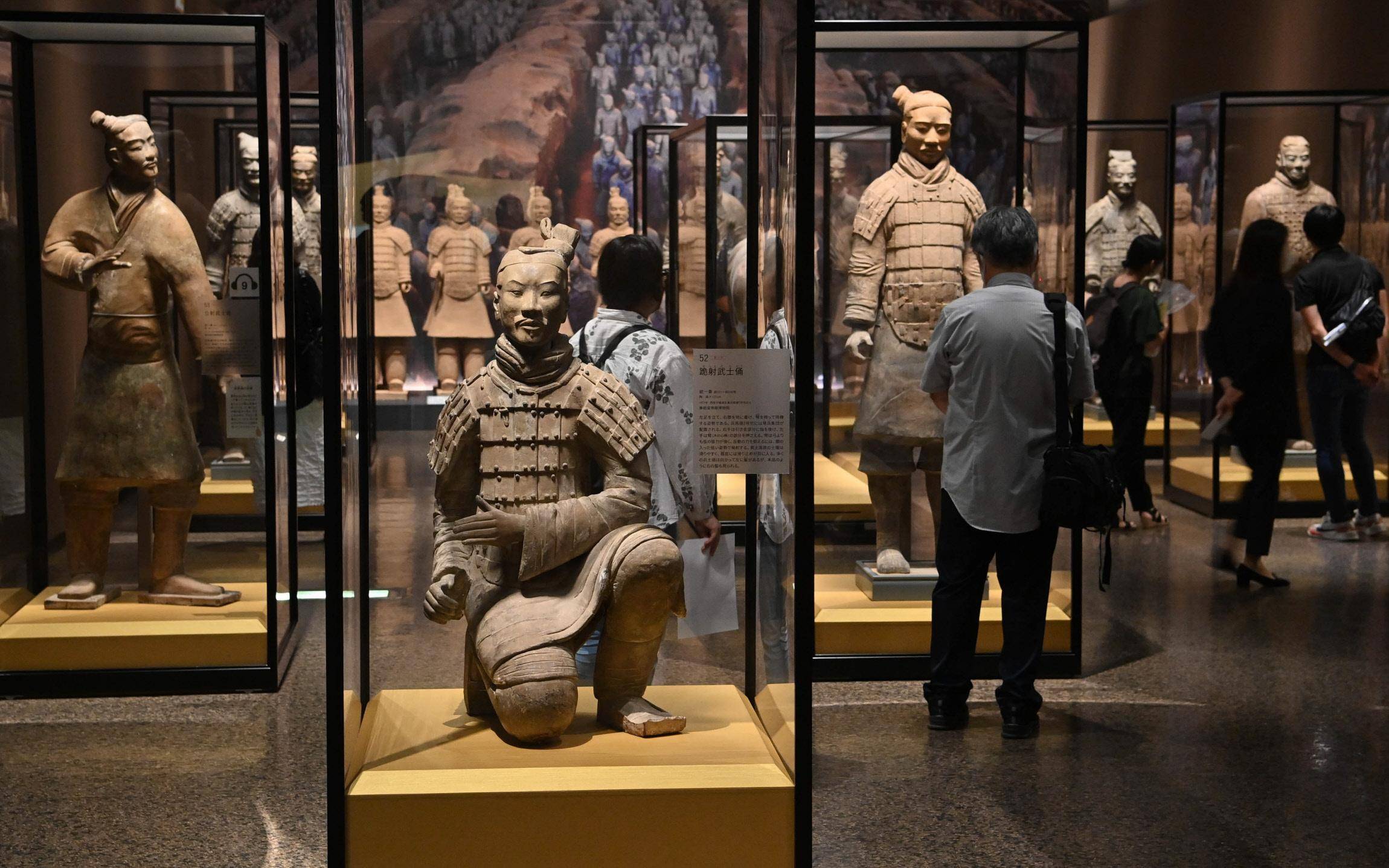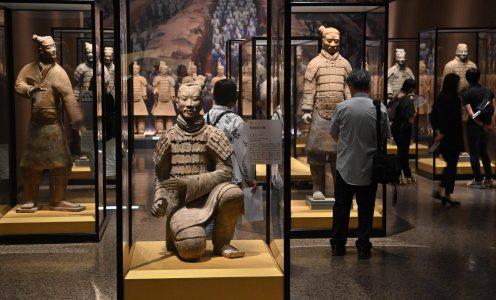Preferential policy
The audience enjoying the free ticket policy are as follows: seniors over 65 years old,minors under 16 years old, disabled people, academicians of Chinese Academy of Sciences and Chinese Academy of Engineering, active soldiers, fire rescue personnel(including retired). Those who enjoy the free ticket policies need to bring relevant valid ID to check the tickets at the entrance of preferential channel.(Chinese nationality)
The following groups enjoy the half-price discount: full-time college degree or below with valid student ID, the half-price discount will be applied to check the tickets at the entrance of half-price discount tickets.
Opening policy
The museum opens from 8:30 a.m. to 17 p.m. during peak season and 8:30 a.m. to16.30 pm. during off-season. The Qin Shi Huang’s Mausoleum Museum consists of the Qin Shi Huang’s Terra-Cotta Warriors and Horses Museum and the Qin Shi Huang’s Mausoleum Archaeological Site Park (Lishan Garden), both of which take 1.5 hours to visit and can be returned by free shuttle bus.
Admission policy
Relevant valid ID
Visitors are required to bring their ID cards (including ID card, Hong Kong and Macao pass, Taiwan Resident permit return permit and passport). No one is allowed to enter the park without them. Preferential customers should bring relevant valid certificates (including military officer’s card, soldier’s card, fireman’s card, student’s card, disability card, etc.) to check and cancel the tickets at the free ticket channel.
Enter the garden time
Enter the park within the scheduled time, if you are outside the time range, you can still enter the park on the day of the scheduled time.
ID card, reimbursement, reservation and other questions
ID problem
You cannot enter the park without your valid ID card. If you lose your ID card, you can bring your Temporary ID card with you.
Missed the scheduled time
You can still enter the park on the day of your reservation.
Reimburse the problem
The park does not provide invoices, and visitors can print reimbursement vouchers by themselves with their ID cards next to the theater in the park.
Ticket refund problem
If you buy the digital ticket in the official channel public account or website,you can refund the ticket in full in the original channel without verification. There fund will be refunded to the original account within 3 to 5 days after the refund. If purchased through other channels, please contact their customer service.
INSTRUCTION OF TERRACOTTA WARRIORS
The Terracotta Warriors, an astonishing archaeological discovery, were uncovered in 1974 near Xi’an, Shaanxi province, China. These life-sized figures were created to protect Emperor Qin Shi Huang in the afterlife. Understanding the structure and pits of the Terracotta Warriors offers a deeper appreciation of their historical and cultural significance. This article delves into the complex organization, the craftsmanship involved, and the archaeological marvel that is the Terracotta Army, ensuring the keyword “Terracotta Warriors” is emphasized appropriately.
Historical Context
The Terracotta Warriors were commissioned by Qin Shi Huang, the first Emperor of China, who unified the country in 221 BCE. His mausoleum complex, where the Terracotta Army was found, reflects the grandeur and authority of his reign. The construction of these figures began around 246 BCE and involved over 700,000 laborers over several decades. The Terracotta Warriors symbolize the emperor’s quest for immortality and his belief in the afterlife.
Discovery and Excavation
The discovery of the Terracotta Warriors in 1974 by local farmers was a monumental event in archaeology. Initial excavations revealed three main pits, each containing thousands of clay soldiers, horses, and chariots. These pits were part of a larger necropolis built to accompany the emperor in the afterlife.
Structure of the Terracotta Warriors
Material and Construction
The Terracotta Warriors are made from local clay, which was molded, fired, and assembled piece by piece. Each figure consists of separate parts: the head, arms, legs, and torso, which were crafted individually and then assembled. This modular construction allowed for mass production while maintaining unique details for each warrior.
Details and Features
Each warrior is distinct, with individualized facial features, expressions, and hairstyles. The artisans paid meticulous attention to detail, creating figures that vary in height, uniform, and rank, reflecting the hierarchical structure of Qin’s army. The warriors were originally painted in bright colors, though most of the paint has faded over time.
The Pits
Pit 1: The Main Army
Pit 1 is the largest and most impressive, measuring approximately 230 meters long and 62 meters wide. It contains over 6,000 warriors arranged in battle formation. The soldiers are primarily infantrymen, armed with bronze weapons and positioned to face east, symbolizing the protection of the emperor’s tomb from potential invaders.
Pit 2: The Mixed Forces
Pit 2, slightly smaller than Pit 1, is about 96 meters long and 84 meters wide. It features a combination of infantry, cavalry, archers, and charioteers, highlighting the diverse components of Qin’s military. The intricate arrangement of these troops illustrates the complexity and strategic depth of the ancient Chinese army.
Pit 3: The Command Center
Pit 3 is the smallest of the three main pits, measuring around 21 meters long and 17 meters wide. It serves as the command post for the army, containing high-ranking officers and a war chariot. The presence of a sacrificial altar indicates its use for ceremonial purposes, further underscoring the spiritual and ritualistic aspects of the Terracotta Army.
Additional Pits and Discoveries
Beyond the three main pits, several smaller pits have been uncovered, revealing additional figures and artifacts. These include acrobats, musicians, and various animals, which provide insights into the cultural and social aspects of the Qin Dynasty. The ongoing excavations continue to shed light on the vastness and complexity of the mausoleum complex.
Significance and Legacy
The Terracotta Warriors are not only a testament to the craftsmanship and engineering prowess of ancient China but also a window into the military, cultural, and political landscape of the time. They represent the emperor’s ambition and the immense resources he commanded. The preservation and study of these figures offer invaluable insights into the Qin Dynasty and its impact on Chinese history.
Photography Tips
Photography is allowed in most areas of the Terracotta Warriors site, but flash photography and tripods are typically prohibited. To capture the best shots:
- Lighting: Visit during the early morning or late afternoon when natural lighting is softer and less harsh.
- Angles: Experiment with different angles to capture the unique details and expressions of the warriors.
- Respectful Photography: Be mindful of other visitors and avoid obstructing their views while taking photos
Best Times to Visit
Visiting the Terracotta Warriors during off-peak times can enhance your experience by avoiding large crowds. The following tips can help you plan your visit:
- Weekdays: Weekdays, especially outside of national holidays and school vacations, are generally less crowded.
- Early Morning or Late Afternoon: Arriving early in the morning or late in the afternoon can help you avoid peak tourist hours.
- Off-Peak Seasons: Consider visiting during the shoulder seasons of spring (April-May) and autumn (September-October) when the weather is mild and the crowds are thinner.
The Terracotta Warriors remain one of the most significant archaeological discoveries of the 20th century. Their intricate construction, the vast scale of the pits, and the historical context of their creation make them a unique and fascinating subject of study. As ongoing excavations and research continue to reveal new findings, the legacy of the Terracotta Warriors and their importance in Chinese heritage grows ever more profound.



hi, are foreigner tourist children and senior also free entry to the site?
Thanks for your question, Below are the Terracotta Army’s Free Admission Policy for Foreigners:
For foreign children under 1.4 meters tall, admission to the Terracotta Army is free.
For foreign students over 1.4 meters tall but under 16 years old, there is a discount for student tickets.
Foreign students over 16 years old who are studying in China can also purchase student tickets
It’s important to note that all free admission policies are for Chinese citizens. Foreigners must follow the relevant regulations to purchase tickets for entry.
To ensure smooth entry, remember to make a reservation in advance and enter the correct passport number. You can enter by scanning your passport at the gate. Enjoy your visit!
I am a foreigner 66 years , do i have free entrance to terracotta
Yes, as a foreigner aged 66, you qualify for free admission to the Terracotta Army Museum (秦始皇帝陵博物院) under its current policies. Here are the key details:
Free Admission Policy:
Visitors aged 65 years or older (including foreigners) are entitled to free entry upon presenting valid identification, such as a passport or other government-issued ID that confirms age .
Required Steps:
Advance Reservation: Even though admission is free, you must book a free ticket in advance through the official website or authorized platforms like the museum’s WeChat account (“秦始皇帝陵博物院”) .
Bring Valid ID: Ensure you carry your passport (or an international senior citizen card) for verification at the entrance .
Additional Notes:
The ticket includes access to both the Terracotta Army Museum and Lishan Garden (秦始皇陵遗址公园). Free shuttle buses connect these two sites .
Avoid unofficial ticket sellers or “discounted tours” near the entrance, as scams are common .
1. Free Entry for Seniors (Aged 65+)
Yes, foreign seniors aged 65 or older qualify for free admission to the Terracotta Army Museum. This policy applies to all nationalities, including foreigners.
Requirements:
Valid ID: Present a passport or government-issued ID confirming your age.
Advance Reservation: Free tickets must be booked in advance via the official website or authorized platforms like the museum’s WeChat account (“兵马俑票务在线”).
2. Free Entry for Children
Foreign tourist children under 16 are not automatically eligible for free entry unless they are Chinese citizens. The policy specifically states:
Free entry for children: Applies only to Chinese nationals aged 16 or younger who are accompanied by a paying adult.
Foreign children: Must purchase a standard ticket unless they hold Chinese citizenship.
3. Key Steps for Foreign Visitors
Book in Advance: All free tickets (including seniors) require prior reservation.
Bring Documentation: Seniors must show a passport; Chinese children need a户口本 (household registration) or ID card.
On-Site Verification: Visit the “Policy Free Ticket” lane for ID checks.
Additional Notes
The free ticket includes access to both the Terracotta Army Museum and Lishan Garden, with free shuttle buses between the sites.
Avoid third-party sellers offering “discounted tickets,” as scams are common near the entrance.
Summary:
✅ Foreign seniors (65+) = Free with reservation and ID.
❌ Foreign children (under 16) = Not free unless they are Chinese citizens.
Hi can i know how to make free booking for terracotta museum for senior citizen(65 years above) if i am from malaysia. Which platform can we book. For example klook dont have pplatform to book ticket for 65 years old and we only key in our passport that dont show our age. Please help
Hi,Tan saw Choo:
Thanks for your message, there is a link on this page where you can click to make booking for terracotta museum ticket.
hello, I am a foreigner 59 years , I am completely deaf in both ears and have speech difficulties. I have an official disability certificate issued by the Spanish government. My brother also has an official disability certificate due to a physical disability, including ulcerative colitis and chronic gastritis.
Do we qualify for free admission or any discounts for people with disabilities? we’ve in mind visit china next september.
Hi Maria:
Thanks for you message,Both you and your brother qualify for free admission to the Terracotta Warriors Museum (Emperor Qinshihuang’s Mausoleum Site Museum) under the current disability policy (as of April 9, 2025):
Disabled individuals: Visitors with valid disability certificates issued by government authorities are eligible for free entry. Foreign disability certificates (e.g., Spain-issued) are generally accepted, but it is recommended to confirm with the museum in advance.
Accompanying caregiver exemption: If your brother’s disability is classified as second-level or higher (e.g., severe physical disabilities), one accompanying caregiver can also enter for free.
Age exemption: At 59 years old, you do not qualify for the free admission for seniors (age 65+), but your disability certificate supersedes this requirement.
How to Apply
Step 1: Online Reservation
Official channels: Use the museum’s official website or its WeChat account (search: 秦始皇帝陵博物院) to access the “Free Ticket Reservation” portal.
Required documents: Upload scanned copies of your passport, disability certificates (with Chinese or English translations), and select your visit date/time.
Step 2: On-site Verification
Documents to bring: Original passport, Spanish disability certificates (with translated versions recommended), and reservation QR code.
Entry: Use the “Disabled Visitors’ Channel” for ticket scanning and verification.
Important Notes
Advance reservation: Free tickets must be booked at least 1 day in advance due to daily quotas.
Translation requirements: Spanish certificates should be translated into Chinese/English. While notarization is not mandatory, it may help avoid delays.
Caregiver exemption: Ensure your brother’s disability certificate clearly states his disability level (second-level or higher) to qualify for a free caregiver ticket.
Contact Information
Ticket inquiries: Call +86-29-81399127 (English service available).
Complaints/emergencies: Dial +86-29-81399174.
For further confirmation about international disability certificates, contact the museum directly via phone or email (available on their official website).